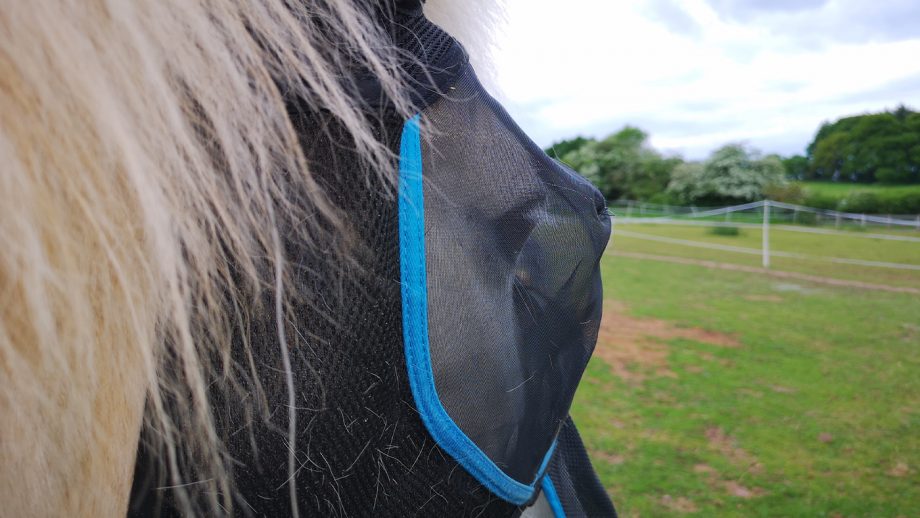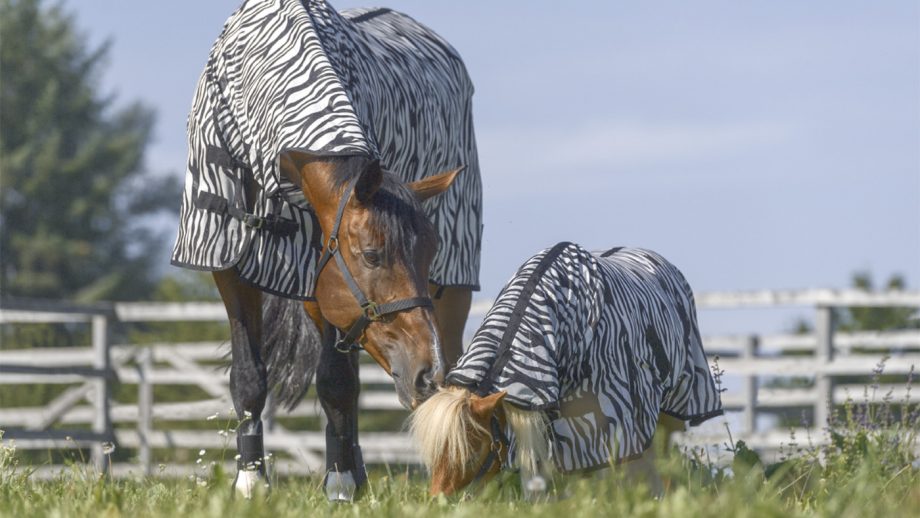Horse flies (Tabinidae) are ever-present pests during the summer, with horse fly bites being a particular problem for horses, and riders, alike. Flies can carry disease and an allergic reaction can result from any fly bite, while all flies cause annoyance and irritation to horses and humans alike – an important consideration when working or competing horses. Methods of protection include horse fly traps, repellents in the forms of sprays and gels, and fly rugs.
What do horse flies look like?
Horse flies are a fairly large, dark, winged insect, that is cylindrical in shape and can measure up to 1in (2.54cm) in length, making them significantly larger than most flies. They have a large head with very large eyes.

A horse fly is a large dark fly that can measure up to an inch in length.
Do horse flies bite?
Female horse flies bite to pierce the skin and feed on a horse – or human’s – blood. They need to drink blood to support their egg production. The insect’s jaw is shaped like scissors and can cut into the skin to access the blood capillaries close to the skin’s surface. Their jaw also has small hooks to help them hold on while sucking the blood, which can make them difficult to dislodge once they have locked on to the skin. The males do not bite – they feed on nectar.
Favourite feeding sites for horse flies include the horse’s underside, legs, neck and withers. They will also bite any exposed areas of human skin. The bites appear as painful papules (pimples) and wheals (small lumps) with a characteristic, central ulcer.
What attracts horse flies?
Horse flies are most active on warm, sultry days and are attracted by dark, rapidly moving objects, sweat and carbon dioxide. As a result dark horses being exercised on warm summer days tend to attract horse flies more so than their lighter counterparts. When protecting horses from flies during turnout, light coloured fly rugs are often used, along with fly repellents and fly traps, such as these on Amazon. These flies will rarely venture into dark areas, so stabling can offer some protection, too.
Where do horse flies live?
The adult horsefly is attracted to areas with moist soil, such as near streams and damp woodland. The females will lay their eggs on wet soil or vegetation that overhangs damp/wet areas so the larvae can burrow into the soft soil and feed on the organic debris and small insects before they transition into the adult fly.
When do horse flies die off?
The flies typically emerge in June and July in the UK and horse fly season lasts throughout the summer months. An individual fly has an adult lifespan of 30–60 days, although the life cycle of the pest is one year.
How to treat horse fly bites
For a one-off bite, apply an ice pack (like this one on Amazon) or bathe with cool, salt water (use a teaspoon of salt to two mugs of water). However, with multiple bites, a mild horse shampoo can help to remove irritating scurf or bacteria and cool the inflamed skin. A topical anti-itch preparation, such as colloidal oatmeal, witch hazel, calamine lotion or zinc oxide cream can also help. In addition, try to prevent the horse making the affected area worse by rubbing. It is rare for a bite to turn septic; if the area is open and weeping, bathe with a mild antiseptic solution, such as Hibiscrub (sold on Amazon), and if this does not help, consult your vet.
How to protect your horse against horse flies
Using barriers, such as anti-midge sweet itch rugs/fly rugs and neck covers, fly masks, fly fringes or other protective gear is a good place to start. If the weather is changeable, a fly rug with water-resistant top panel may be useful, too.
Horse fly repellents
In general, home-made fly repellents are of little benefit against horseflies, as they are robust creatures. Insecticides known as synthetic pyrethroids – especially permethrin or cypermethrin – offer the best solution and can be bought online. Follow the directions on the product, as many are not suitable for daily use and always do a spot test on a small area first to test for sensitivity. Insecticides can be applied to stables and field shelters to help eliminate the insects.
Horse fly traps
There are a range of horse fly traps available that are designed to attract the flies, before trapping the insects to prevent breeding.

Zone In Fly Trap | Amazon
This giant, reusable fly trap lures and kills up to 60,000 flies. Bait included.
Other types of flies that trouble horses
Black flies (Simuliidae) are small in size (approximately 2–5mm) and breed in rapidly moving water. High-risk times are dawn and dusk during spring and early summer, when stabling may be helpful. These flies commonly feed around the face – particularly inside the ears, where they trigger allergic skin reactions to their saliva, and distract the horse – but also on the horse’s neck and underside. Bites form as painful lumps, often with pin-prick areas of bleeding and crusting.
Synthetic pyrethroid fly sprays can act as a deterrent, although physical barriers such as ear nets and oil-based products – oil of citronella, for example – will discourage these flies from landing on the horse. Petroleum jelly applied inside the ears may prevent the insects biting.
Midges (Culicoides) are 1mm-3mm long and hover in swarms at dawn and dusk. Eggs are laid in standing water, so avoid stagnant areas. Different species of midges feed at different sites on the horse. Classically, mane and tail hairs are broken or rubbed away, exacerbating sweet itch in animals that are allergic to the bites.
Insect repellents can be very effective against these pests. Permethrin-based products are best and should be applied in late afternoon. Oil-based products can be applied several times daily to prevent flies landing. Bringing horses in before dusk and using a fan to create a brisk breeze helps keep midges away, while rugs may also be useful.
Stable flies lay eggs in moist, rotting vegetation – typically, hay or silage that is contaminated with urine, water or manure – so are associated with poor hygiene. They feed on horses’ legs and abdomens, and bites typically appear as itchy or painful wheals or papules with a central crust. The best prevention is to maintain high hygiene standards, but repellents can also be used. Permethrin-based products are most effective directed at the legs.
Other problematic insects include mosquitoes, bees and wasps – these produce uncomfortable bites, as well as causing alarm to horses. While wasps and bees are present throughout the day, mosquitoes are at their worst in the two hours after sunset.
As they are alkaline, wasp stings should be bathed with a dilute acid, such as vinegar or lemon juice. Bee stings, however, are acidic and should be bathed with bicarbonate of soda. The bee leaves its sting behind, so try to remove this with tweezers, as venom will continue to enter the skin. If the stinger is below the surface, it will be shed with normal skin healing.
Other methods to prevent flies
- Eliminate puddles and ponds of still water, where midges might breed
- Practise good hygiene around the yard
- Worm horses against bot flies in winter
- Keep horses in when the flies are bad
- Use a fan in the stable to blow away flies
You may find these useful…

Had enough of annoying flies? We’ve tested some fly sprays to find which really work

Fly masks to protect your horse

13 fly rugs to suit every shape, need and budget

10 waterproof fly rugs – perfect for summer showers and sunshine

Subscribe to Horse & Hound magazine today – and enjoy unlimited website access all year round
Horse & Hound magazine, out every Thursday, is packed with all the latest news and reports, as well as interviews, specials, nostalgia, vet and training advice. Find how you can enjoy the magazine delivered to your door every week, plus options to upgrade your subscription to access our online service that brings you breaking news and reports as well as other benefits.





